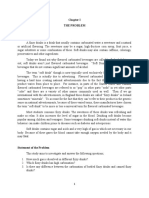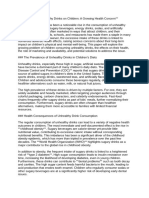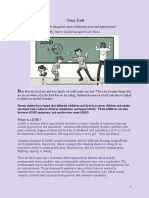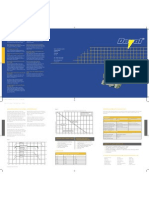RD Enlgish Term Paper
RD Enlgish Term Paper
Uploaded by
api-249000249Copyright:
Available Formats
RD Enlgish Term Paper
RD Enlgish Term Paper
Uploaded by
api-249000249Original Title
Copyright
Available Formats
Share this document
Did you find this document useful?
Is this content inappropriate?
Copyright:
Available Formats
RD Enlgish Term Paper
RD Enlgish Term Paper
Uploaded by
api-249000249Copyright:
Available Formats
Soft Drinks In Schools
Randy Lamb
12 April 2014
Grant Bangerter
English 1010
Soft Drinks in Schools
In 1807, Doctor Philip Syng Physick mixed together several different herbs with
carbonated water creating the worlds first flavored soft drink (Bellis, 2014). Since then
the soft drink industry has grown to a multi billion-dollar industry, making it one of the
most profitable industries in the world. In the early 1950s the first vending machine was
placed in a school, the response from students was so over whelming that it was soon
after that every school in America had one of these contraptions (Olver, 2014). For the
last decade this partnership between soft drink companies and schools has come under
attack. There are many health issues that are caused by students who drink soft drinks
regularly, but there are many benefits allowing soft drink companies to place vending
machines in schools. Soft drinks in school can have a positive impact for education, but a
negative impact on the health of the student.
Health Issues
Many health issues can develop by those who drink soft drinks on a regular basis.
The biggest problem is obesity. In the 1950s soft drinks came in 6.5-ounce cans, today
the average serving of a soft drink is 20 ounces or more. Americans consume nine
percent of their calories through the use of soft drinks daily (Harvard, 2014). With the
increase of ounces that one consumes from soft drinks, the calories also increases, which
will cause obesity in adults and children.
Students that consume soft drinks have had a growing trend. In 1995 to 2001 a
study was done about school aged children and obesity. For the age group of 5-11 there
was a forty percent increase in number of children that were obese. For teenagers, 12-19
there was a fourteen percent increase. This number has only gone up since 2001 since the
amount that children consume has gone up twelve percent (University of North Carolina,
2001).
The average American will consume 56 gallons a year or one and a half 12 ounce
cans a day of soft drinks. Sugar has been linked to tooth decay, but what is worse is the
acid inside soft drinks that eats the enamel from your teeth. Most children start to drink
soft drinks at a young age, and drink 7 ounces a day. The combination of acid, sugar, and
lack of oral hygiene has created an epidemic of tooth decay in our country (Rindelaub,
2001).
Diabetes has been linked to the ingestion of massive amounts of sugar. The
second ingredient in most soft drinks is some sort of a processed sweetener. What
happens is that your body will intake the sugar but not be able to get rid of it quickly.
This will keep your pancreas working non-stop producing insulin and eventually damage
it. Once it is damaged your body will not be able to produce enough insulin to break
down the sugar, causing diabetes. People who consume soft drinks daily have a 26
percent more chance of developing diabetes (Boyles, 2008).
The consumption of caffeine can have different effects on your body. Caffeine
will shrink your brain cells, which in most cases will relieve a headache. Other people
will have an opposite affect to where it increases headache pain. Those that do consume
large amounts of caffeine will get severe headaches after a long period of no
consumption. The same goes for how alert and attentive you are while consuming these
beverages.
Another big problem in the United States is that as our lives get less complicated
by machines, we are becoming lazier. People replace the aerobic exercise of every day
life with watching T.V., playing video games, and becoming couch potatoes. Exercise is
essential for our bodies. If we do not exercise our body will not be able to burn up the
calories that we intake, soft drinks are no exception. If human beings were to exercise
more, most of the obesity problems would disappear. Instead we chose to be lazy
(Dotinga, 2008).
Soft Drinks in Schools
Soft drinks have been apart of school life for over 60 years. Now many states are
issuing bans on the sale of soft drinks made with sugar, to prevent the above health issues
in children. What is happening is that while the sale of soft drinks in these schools is
going down, the sale of soft drinks in the surrounding convenient stores and grocery
stores has doubled during school hours (Pelo, 2014). Students that want to drink soft
drinks will still get them. If they cant get them from school, they will get them from
somewhere else. These bans have had little to no effect on students drinking soft drinks.
It might be better to offer them at school to avoid students leaving school, with
possibilities of tardiness or having other issues that can be caused from leaving school.
Some of these bans have allowed soft drink companies to place healthier
options in school vending machines. Some of these choices that are approved are sports
drinks, juices, milk products, diet soft drinks (some states), diet energy drinks (some
states), and water. These approved options are packed with just as many calories, sugar,
and acid as a regular soft drink. These beverages can be just or more harmful than a
regular sugar sweetened soda.
Sports drinks have a lot of sugar, up to a quarter of a cup, this is to give you a
quick pick me up to get back into the game. However these sports drinks can damage
your teeth more than soft drinks due to the high amounts of sugar. Other side affects can
include severe dehydration and high blood pressure (Johnson, 2011). The juices and milk
products are packed with sugar and other preservatives to allow a longer shelf life.
Diet drinks can be more harmful than sugar sweetened beverages. Some common
issues with diet drinks are kidney problems, messed-up metabolism, obesity, cell
damage, rotting teeth, and reproductive issues. The biggest problem with the sweeteners
that are used in diet soda is that it is created in a lab. Your body cannot process many of
these chemicals. This forces them through organs like your kidneys, and damages them
as they pass through. Just because it says it is a diet soda does not make it one. The
University of Texas did an eleven-year study on women who drank diet sodas. They
found that women who drank diet sodas regularly were more obese than those that drank
soda with natural sweeteners. The artificial sweeteners disrupt the bodys ability to
regulate calorie intake (Oklander, 2014). Aspartame was originally invented as a rat
poison. Scientist found that rats would eat it because of its sweetness, after which it kills
them by making them thirsty. It was found by accident that it was a good sweetener for
food for humans. Now it is the most popular artificial sweetener in the United States.
This so-called rat poison is considered to be a healthy option for children in schools.
Energy drinks are packed with a lot of caffeine and a lot of other things just to get
your body moving, however the majority of items in energy drinks are harmful to your
body. After the pick you up that you receive from an energy drink your body crashes
causing severe fatigue. Many health problems are linked to drinking these beverages.
Some are cardiac arrest, headaches, insomnia, diabetes, risky behavior, nervousness,
vomiting, and allergic reactions (Caffeine Informer, 2014). Most energy drink cans have
warnings on them listing some of these issues. I have not found an article that lists
benefits of drinking an energy drink; everything that I have read lists them as a health
hazard. A personal witness to the dangers of these drinks is that we left a leaking pallet in
the warehouse for about a week; the liquid from these energy drinks ate through the
concrete floor. I have not had one since.
After looking at these beverages it is clear that they truly are not healthier options.
Most of them are packed with more sugar and artificial items that can be more harmful
than a regular soft drink. If healthy options are going to be allowed they should stick to
water and fresh milk. That is the big debate; students want soft drinks over these other
two options, and will get them whether it is from school or leaving school grounds to get
them.
Soft Drink Companies and Schools
There has been a relationship between soft drink companies and schools for the
pass fifty years. Schools have made contracts with these companies to get extra income.
This income is spent on things the school needs that their normal income does not pay
for. When a school agrees to place a soft drink machine in their school they get a percent
of what is sold in their school. Usually they receive a fifty-five percent commission rate.
The usual rate given to other organizations is around twenty-five percent. Some of these
contracts include a guarantee of a specific dollar amount. One school district in Arizona
receives $393,122 a year as extra income to their extra curricular activities (Ryman,
2004). These numbers show a generous donation from a soft drink company. We see a
need and try to fill it, because we can. (Pelo, 2014)
Soft drink companies also donate many items that schools need. We have
donated computer labs to several schools in the Salt Lake area. We have donated ipads to
all of the schools we have contracts with. We have donated electric signs, grass for
football fields, material to build a new running track, and we have even bought new
curtains for a school auditorium. (Pelo, 2014) Many of these items have been worked
into contracts that the schools have signed with a soft drink company. Eighty percent of
the schools in the United States have had a contract with these companies and benefitted
from them, providing things that the government would not help with.
Coca Cola has been a big supporter of science, technology, engineering, and
mathematics (STEM) education. They realize that future advancements in technology
will come from the students that they are investing in today. With the investments into
these programs they help inspire students in these fields (STEM Connector, 2014.)
Soft drink companies have given many scholarships to high school students each
year. Coca Cola each year helps support 1,400 college students. They spend over 3.4
million on scholarships for these students (Coca Cola Scholars, 2013). Pepsi Cola offers
fourteen $5,000 scholarships and one $10,000 scholarship per state. The Dr. Pepper
Company offers millions of dollars to scholarships each year. Soft drink companies put
education high in their goals and tries to help students reach their goals.
Soft drink companies try to be a community partners. They donate millions to
many charitable organizations such as United Way. The United Way has goals to help
needy children attend school, help them through it, and watch them graduate. Without the
donations from soft drink companies many children would continue to not attend school.
Many of the profits that are made by the vending machines in school goes to fund
programs to help children in Africa attend school. Coca-Cola and Pepsi Cola both have
invested millions of dollars to build public schools and offer scholarships for eleven
countries across Africa. These programs would not be available with out the profits they
receive from schools in the United States (Coca-Cola, 2011).
Soft drink companies receive very little for the millions of dollars they put into
education. They receive some advertising to their future customers. The pay millions so
that a few students will see their logo on a vending machine and make future purchases
from their products.
Removing soft drinks from schools will damage their ability to provide funds for
items that the state is unable to. Schools benefit when a soda machine is placed inside
their school. Those that use it help their school fund programs that usually would not
happen without it. Most of the time those who make a purchase from it are those that will
go next door to the convenient store if they dont have the option in school.
Conclusion
This debate will continue for a long time. There are many things to consider. The
health of a child is important as well as providing a good education for them. Obesity and
other health issues can be linked to drinking soda regularly. However allowing soft drinks
in schools can provide items that schools cannot afford with out this extra income that is
provided to them by the soft drink industry. Many positive health changes can come from
taking soda out of schools, but many positive financial changes can come from allowing
soda into schools.
Works Cited
Bellis, Marry. Introduction to Pop The History of Soft Drinks. About.com. Web 12
April 2014. <http://inventors.about.com/od/foodrelatedinventions/a/soft_drinks.htm
Boyles, Salynn. Soda and your Health: Risks Debated. WebMD. Web 30 March 2014.
< http://www.webmd.com/diet/features/sodas-and-your-health-risks-debated
Caffeine Informer. Top Ten Energy Drink Dangers. Caffeine Informer. Web 12 April
2014 < http://www.caffeineinformer.com/top-10-energy-drink-dangers
Coca Cola. A Decade of Change. Coca Cola 2011. Web 12 April 2014
<http://www.tccaf.org/coca-cola-africa-foundation-education.asp
Coca Cola Scholars. Our Scholarship Program. Coca Cola 2013. Web 12 April 2014 <
http://www.coca-colascholarsfoundation.org/applicants/#.U1VRkl5bTwI
Dotinga, Randy. Banning Soft Drinks in Schools has Small Impact. US News. 12
September, 2008. Web. 30 March 2014. <http://health.usnews.com/health-news/family-
health/childrens-health/articles/2008/09/12/banning-soft-drinks-in-schools-has-small-
impact
Johnson, Lorie. Health risks tied to Energy, Sports Drinks. CBN News. 15 July 2011.
Web 12 April 2014 < http://www.cbn.com/cbnnews/healthscience/2011/march/health-
risks-tied-to-energy-sports-drinks-/
Harvard School of Public Health. Sugary Drinks and Obesity fact sheet. Harvard. Web
12 April 2014 < http://www.hsph.harvard.edu/nutritionsource/sugary-drinks-fact-sheet/
North Carolina University. Soft Drinks and School Aged Children. North Carolina
University. July 2002. Web 12 April 2014
< http://www.ncdhhs.gov/dph/oralhealth/library/includes/ed-
materials/Soft_Drinks_and_School_Age_Children.pdf
Oklander, Mandy. 7 Side Affects of Drinking Diet Soda. MSN.com 14 April 2014.
Web 14 April 2014 < http://healthyliving.msn.com/health-wellness/7-side-effects-of-
drinking-diet-soda
Olver, Lynne. Food Timeline: FAQs of School Lunch. Foodtimeline.com 7 March
2014. Web 12 April 2014. < http://www.foodtimeline.org/foodschools.html
Pelo, Jack. Personal interview with Swire Coca-Cola CEO. 26 March 2014
Rindelaub, Darcy. Soft drinks: Hard on teeth. Clinical Feature. April 2001. Web 12
April 2014.
<http://www.sipallday.org/userfiles/ckfiles/files/Soft_Drinks_Hard_on_Teeth.pdf
Ryman, Anne. Schools Get Big Bucks From Soft Drink Companies. Arizona Republic
4 January 2004. Web 12 April 2014 < http://nepc.colorado.edu/files/CERU-0401-188-
OWI.pdf
STEM Connector. Coca Cola. STEM Connector 2014. Web 12 April 2014
<http://www.stemconnector.org/coca-cola
You might also like
- Extraction of Caffeine From Tea Leaves Experiment Formal ReportDocument6 pagesExtraction of Caffeine From Tea Leaves Experiment Formal ReportChristeline Fernandez67% (3)
- Nutrition Lesson Plan - Drinks Food LabelsDocument6 pagesNutrition Lesson Plan - Drinks Food Labelsapi-311026309No ratings yet
- Carbonation Content in Different Fizzy DrinksDocument34 pagesCarbonation Content in Different Fizzy Drinks03เขตโสภณ สัมมาNo ratings yet
- Search Party 1x01 - PilotDocument30 pagesSearch Party 1x01 - Pilotagxz100% (1)
- Final Draft Argument EssayDocument7 pagesFinal Draft Argument Essayapi-302857837No ratings yet
- Foods in Fridge NewDocument15 pagesFoods in Fridge Newtopcat7No ratings yet
- Pop Research PaperDocument14 pagesPop Research Paperapi-253449395No ratings yet
- fsn310 - Research PaperDocument8 pagesfsn310 - Research Paperapi-300301211No ratings yet
- Bcervantes LitreviewfinalDocument12 pagesBcervantes Litreviewfinalapi-355764544No ratings yet
- Argumentative Persuasive Essay SampleDocument1 pageArgumentative Persuasive Essay Samplejulian bakerNo ratings yet
- Together We Can!: Why Is Drinking Water Important To Our Health?Document3 pagesTogether We Can!: Why Is Drinking Water Important To Our Health?Chad LeoNo ratings yet
- Mini ResearchDocument26 pagesMini ResearchRizky Dwi ZhafiraNo ratings yet
- Energy Drinks SynthesisDocument5 pagesEnergy Drinks Synthesisapi-482110299No ratings yet
- Completed Final Paper Preventing Essay On Childhood ObesityDocument10 pagesCompleted Final Paper Preventing Essay On Childhood ObesityJeanne GarvinNo ratings yet
- Introduction To Beverage-1Document14 pagesIntroduction To Beverage-1Muhammad Talha KhanNo ratings yet
- Research PaperDocument17 pagesResearch PaperHyacinth Gasmin83% (6)
- Cole Walton - Argumentative EssayDocument6 pagesCole Walton - Argumentative Essayapi-549031804No ratings yet
- Synthesis EssayDocument7 pagesSynthesis Essayapi-482016467No ratings yet
- Argumentative EssayDocument8 pagesArgumentative EssayHeilyn MoraNo ratings yet
- Edited Sugary Drinks and Child ObesityDocument4 pagesEdited Sugary Drinks and Child ObesityChristopher Rodriguez PerezNo ratings yet
- The Impact of Unhealthy Drinks On Children: A Growing Health ConcernDocument3 pagesThe Impact of Unhealthy Drinks On Children: A Growing Health ConcernbihafepuheboNo ratings yet
- ThesisDocument45 pagesThesisLouie Trinidad0% (1)
- Sugar Drink Consumption Fact SheetDocument3 pagesSugar Drink Consumption Fact SheetMarcosNo ratings yet
- Argument Essay 1010Document5 pagesArgument Essay 1010api-242887418No ratings yet
- ObeseDocument5 pagesObeseteresalopNo ratings yet
- RethinkDocument9 pagesRethinkIren ShuflinNo ratings yet
- Adhd ManifestoDocument9 pagesAdhd ManifestokarlymaeNo ratings yet
- Junk Food and FIGS BenefitsDocument16 pagesJunk Food and FIGS BenefitsTaqi MohammedNo ratings yet
- Should Government Impose Restrictions On What Kinds of Foods Can Be Served in School CafeteriasDocument9 pagesShould Government Impose Restrictions On What Kinds of Foods Can Be Served in School CafeteriasharonNo ratings yet
- Childhood Obesity English 102Document6 pagesChildhood Obesity English 102jbell48No ratings yet
- Soft Drinks and School-Age ChildrenDocument6 pagesSoft Drinks and School-Age ChildrenkalikNo ratings yet
- Energy Drinks and CaffeineDocument13 pagesEnergy Drinks and CaffeineJuan PabloNo ratings yet
- fcs400 FinalcdpaperDocument8 pagesfcs400 Finalcdpaperapi-282741728No ratings yet
- HyperactivityDocument4 pagesHyperactivityapi-572830470No ratings yet
- Arguement EssayDocument5 pagesArguement Essayapi-492295870No ratings yet
- Childhood Obesity in The Rio Grande ValleyDocument6 pagesChildhood Obesity in The Rio Grande ValleydjwickedNo ratings yet
- Caffeine Effects On HealthDocument17 pagesCaffeine Effects On HealthSurendra HolkarNo ratings yet
- Child Obesity in America Literature ReviewDocument10 pagesChild Obesity in America Literature Reviewapi-254067841No ratings yet
- Drink Preferences & Academic Performanc Among Bachelor of Physical Education Major in School Phsycical EducationDocument34 pagesDrink Preferences & Academic Performanc Among Bachelor of Physical Education Major in School Phsycical EducationOnie SunNo ratings yet
- Unit 1 - ReadingDocument7 pagesUnit 1 - Readingggvbng9njrNo ratings yet
- How Our Sweet Tooth Is Hurting UsDocument1 pageHow Our Sweet Tooth Is Hurting UsMy Hanh MaiNo ratings yet
- Unit 1: Exercise 1: Answer The Questions. Choose ONE WORD OR A NUMBER From The Passage For Each AnswerDocument2 pagesUnit 1: Exercise 1: Answer The Questions. Choose ONE WORD OR A NUMBER From The Passage For Each AnswerNguyễn BiwoolzzNo ratings yet
- 1, Energy Drinks Article and QuestionsDocument2 pages1, Energy Drinks Article and QuestionsharrypatrickoneillNo ratings yet
- Тести для Танюши) )Document4 pagesТести для Танюши) )pp1445677No ratings yet
- Sugary Drinks Should Not Be Sold in SchoolsDocument1 pageSugary Drinks Should Not Be Sold in SchoolsLorie-Ann LawsonNo ratings yet
- Soft Drinks Research PaperDocument13 pagesSoft Drinks Research PaperAndré BrutusNo ratings yet
- Effect of Junk Food in Daily Life Investigatory ProjectDocument11 pagesEffect of Junk Food in Daily Life Investigatory ProjectKristine Marie Baranda ZarateNo ratings yet
- Cola Drink Are Bad For Your HealthDocument4 pagesCola Drink Are Bad For Your HealthLydia AfzanNo ratings yet
- Drinking While Doing HomeworkDocument4 pagesDrinking While Doing Homeworkafmtfanym100% (1)
- InterpretationDocument5 pagesInterpretationHoàng Hải TrươngNo ratings yet
- Sample SBADocument16 pagesSample SBAshamonajohnson033No ratings yet
- Speaking PracticeDocument7 pagesSpeaking PracticeIrfan AkramNo ratings yet
- Aidan Kohn Murphy Chocolate Milk TestimonyDocument10 pagesAidan Kohn Murphy Chocolate Milk TestimonymdebonisNo ratings yet
- IELTS Cause-Problem and Effect-Solution Model EssayDocument17 pagesIELTS Cause-Problem and Effect-Solution Model EssaySayaf RashadNo ratings yet
- Children Find Themselves Amidst A Complex Society That Is Undergoing Breathtaking ChangesDocument5 pagesChildren Find Themselves Amidst A Complex Society That Is Undergoing Breathtaking ChangesTruly AsworoNo ratings yet
- Summary AnalyssDocument4 pagesSummary AnalyssElen MustikaNo ratings yet
- Soft Drinks Hard On TeethDocument5 pagesSoft Drinks Hard On TeethPrajwal SethNo ratings yet
- Thesis Statement Examples On Childhood ObesityDocument8 pagesThesis Statement Examples On Childhood Obesityjaclyncreedonannarbor100% (2)
- Unit 1 - ReadingDocument8 pagesUnit 1 - ReadingAndrew Wu57% (7)
- The No Sugar Diet: How to Lose 5lbs in Just 7 Days by Cutting Out Sugar From Your DietFrom EverandThe No Sugar Diet: How to Lose 5lbs in Just 7 Days by Cutting Out Sugar From Your DietRating: 3.5 out of 5 stars3.5/5 (4)
- Accomplishmenrt Report SampleDocument2 pagesAccomplishmenrt Report SampleHikari KurisutaruNo ratings yet
- Brahmin Iyer Kitchen RecipeDocument54 pagesBrahmin Iyer Kitchen Recipelogas_p50% (2)
- BÀI TẬP VỀ THÌ HIỆN TẠI ĐƠNDocument12 pagesBÀI TẬP VỀ THÌ HIỆN TẠI ĐƠNThư NguyễnNo ratings yet
- Batangas City Revenue Code of 2009Document168 pagesBatangas City Revenue Code of 2009jamie67% (3)
- Devol ValveDocument2 pagesDevol ValveRoo FaNo ratings yet
- (L P 9) Unit 7 Lesson 1Document6 pages(L P 9) Unit 7 Lesson 1Anh Le NguyetNo ratings yet
- BenihanaDocument18 pagesBenihanaVieri50% (2)
- Formylation of Alcohol With Formic Acid Under Solvent-Free and Neutral Conditions Catalyzed by Free I Ori Generated in Situ From Fe (No) 9H O/NaiDocument5 pagesFormylation of Alcohol With Formic Acid Under Solvent-Free and Neutral Conditions Catalyzed by Free I Ori Generated in Situ From Fe (No) 9H O/Naibutko88No ratings yet
- Designated Outdoor Refreshment Area: Norman's NicheDocument14 pagesDesignated Outdoor Refreshment Area: Norman's NicheGere GobleNo ratings yet
- Anaerobic Respiration in Yeast CellsDocument3 pagesAnaerobic Respiration in Yeast CellsAyanna Grant40% (5)
- European Anubhav - Anand Yatra Summer 2013 PDFDocument9 pagesEuropean Anubhav - Anand Yatra Summer 2013 PDFJames AndersonNo ratings yet
- Hobbycook - Gift PacksDocument22 pagesHobbycook - Gift PacksDeepak SinghNo ratings yet
- LvmiBrthls - JEMlpsDocument337 pagesLvmiBrthls - JEMlpsRadosavljevic Marina100% (1)
- Pour Over/Drip: Coffee Cone: A Quick Guide To Manual Coffee Making StylesDocument5 pagesPour Over/Drip: Coffee Cone: A Quick Guide To Manual Coffee Making StylesRishabh GuptaNo ratings yet
- Nelson - Salmo Pennywise April 8, 2014Document48 pagesNelson - Salmo Pennywise April 8, 2014Pennywise PublishingNo ratings yet
- Workshop Nouns QuantifiersDocument6 pagesWorkshop Nouns QuantifiersJoher TraslavinaNo ratings yet
- Stock List As OnDocument19 pagesStock List As OnSita SinghNo ratings yet
- DishDocument132 pagesDishAgung LinapNo ratings yet
- The Thirty Nine Steps PDFDocument103 pagesThe Thirty Nine Steps PDFkanchansamudrawarNo ratings yet
- Babylon Revisited - SparkNotesDocument14 pagesBabylon Revisited - SparkNotesDin Min TuanNo ratings yet
- Ratio WordingDocument2 pagesRatio Wordingapi-3769094080% (1)
- Hafiz On Danforth AvenueDocument4 pagesHafiz On Danforth Avenueapi-261723412No ratings yet
- Menu Board RT RotisserieDocument2 pagesMenu Board RT RotisserieCaleb Pershan100% (1)
- Exercises A. Opposites - Adjectives 1Document6 pagesExercises A. Opposites - Adjectives 1Rolan Royer MoriNo ratings yet
- Starbucks v. Phil & Sons PDFDocument28 pagesStarbucks v. Phil & Sons PDFMark JaffeNo ratings yet
- Final Cure For DiabetesDocument11 pagesFinal Cure For Diabetesdarlene918100% (2)
- Vietnamese Sugar Cane Shrimp (Chao Tom) : Tamarind SauceDocument8 pagesVietnamese Sugar Cane Shrimp (Chao Tom) : Tamarind SauceJeffFownNo ratings yet

























































































